特应性皮炎的治疗共31页文档
特应性皮炎的合理药物治疗
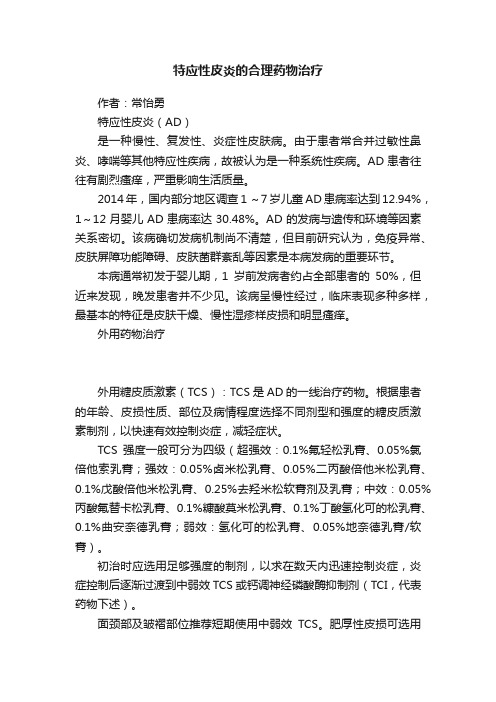
特应性皮炎的合理药物治疗作者:常怡勇特应性皮炎(AD)是一种慢性、复发性、炎症性皮肤病。
由于患者常合并过敏性鼻炎、哮喘等其他特应性疾病,故被认为是一种系统性疾病。
AD患者往往有剧烈瘙痒,严重影响生活质量。
2014年,国内部分地区调查1 ~7岁儿童AD患病率达到12.94%,1~12月婴儿AD患病率达30.48%。
AD的发病与遗传和环境等因素关系密切。
该病确切发病机制尚不清楚,但目前研究认为,免疫异常、皮肤屏障功能障碍、皮肤菌群紊乱等因素是本病发病的重要环节。
本病通常初发于婴儿期,1岁前发病者约占全部患者的50%,但近来发现,晚发患者并不少见。
该病呈慢性经过,临床表现多种多样,最基本的特征是皮肤干燥、慢性湿疹样皮损和明显瘙痒。
外用药物治疗外用糖皮质激素(TCS):TCS是AD的一线治疗药物。
根据患者的年龄、皮损性质、部位及病情程度选择不同剂型和强度的糖皮质激素制剂,以快速有效控制炎症,减轻症状。
TCS强度一般可分为四级(超强效:0.1%氟轻松乳膏、0.05%氯倍他索乳膏;强效:0.05%卤米松乳膏、0.05%二丙酸倍他米松乳膏、0.1%戊酸倍他米松乳膏、0.25%去羟米松软膏剂及乳膏;中效:0.05%丙酸氟替卡松乳膏、0.1%糠酸莫米松乳膏、0.1%丁酸氢化可的松乳膏、0.1%曲安奈德乳膏;弱效:氢化可的松乳膏、0.05%地奈德乳膏/软膏)。
初治时应选用足够强度的制剂,以求在数天内迅速控制炎症,炎症控制后逐渐过渡到中弱效TCS或钙调神经磷酸酶抑制剂(TCI,代表药物下述)。
面颈部及皱褶部位推荐短期使用中弱效TCS。
肥厚性皮损可选用封包疗法。
急性期泛发性严重或者顽固皮损推荐短期(通常3 d,时间不超过14 d)湿包治疗,可快速有效控制症状,该疗法特别适用于不宜系统用药的儿童患者,但要注意长期大面积使用TCS可能导致皮肤和系统不良反应。
中重度或易复发AD患者皮损控制后,应过渡到长期“主动维持治疗”,即在易复发的原有皮损区每周2次外用TCS或TCI,配合全身外用保湿润肤剂,能有效减少复发,减少外用糖皮质激素用量。
特应性皮炎的治疗方法

特应性皮炎的治疗方法
特应性皮炎(atopic dermatitis)是一种慢性炎症性皮肤病,治疗方法包括药物治疗和非药物治疗。
药物治疗:
1. 外用药物:包括激素类药物(如糖皮质激素)、非激素类抗炎药物(如钙调神经肽相关肽类药物)和免疫调节剂(如非甾体类抗炎药物等)。
2. 内服药物:针对中度到重度的病情,医生可能会开具口服抗组胺药物、非甾体类抗炎药或免疫抑制剂等。
非药物治疗:
1. 保湿:使用保湿霜或乳液,保持皮肤水分,预防干燥和湿疹恶化。
2. 避免刺激物:避免使用刺激性洗涤剂、肥皂、香水等,并尽量选择纯棉衣物和床上用品,以减少对皮肤的刺激和摩擦。
3. 冷热敷:冷敷可以减轻瘙痒感,热敷则有助于皮肤湿疹的愈合。
4. 应对精神压力:避免情绪波动、压力过大,因为精神压力可能会加重特应性皮炎症状。
此外,对于婴儿或儿童的特应性皮炎,还需要家人做好日常护理,如每天的沐浴、保湿和穿着透气的衣物等。
务必咨询医生,找到适合个人情况的治疗方法。
2015 KADA共识指南:特应性皮炎的治疗(第1部分:综合管理和局部治疗)
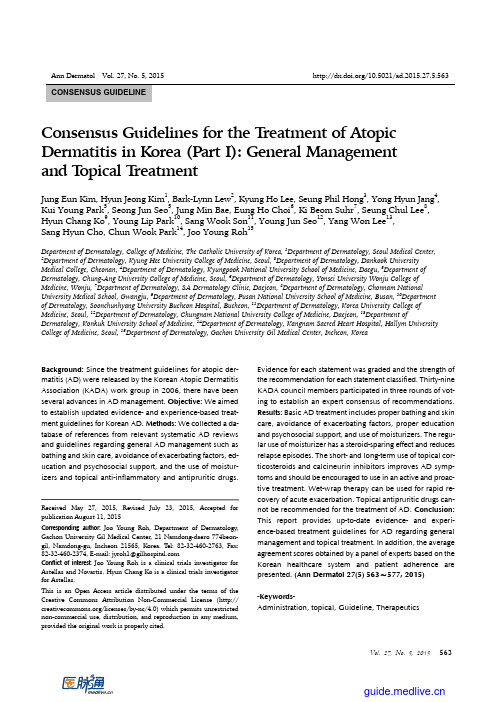
Received May 27, 2015, Revised July 23, 2015, Accepted for publication August 11, 2015Corresponding author: Joo Y oung Roh, Department of Dermatology,Gachon University Gil Medical Center, 21 Namdong-daero 774beon- gil, Namdong-gu, Incheon 21565, Korea. T el: 82-32-460-2763, Fax: 82-32-460-2374, E-mail: jyroh1@Conflict of interest: Joo Y oung Roh is a clinical trials investigator for Astellas and Novartis. Hyun Chang Ko is a clinical trials investigator for Astellas.This is an Open Access article distributed under the terms of the Creative Commons Attribution Non-Commercial License (http:// /licenses/by-nc/4.0) which permits unrestricted non-commercial use, distribution, and reproduction in any medium, provided the original work is properly cited.Ann Dermatol Vol. 27, No. 5, 2015/10.5021/ad.2015.27.5.563Consensus Guidelines for the T reatment of Atopic Dermatitis in Korea (Part I): General Management and T opical T reatmentJung Eun Kim, Hyun Jeong Kim 1, Bark-Lynn Lew 2, Kyung Ho Lee, Seung Phil Hong 3, Yong Hyun Jang 4,Kui Young Park 5, Seong Jun Seo 5, Jung Min Bae, Eung Ho Choi 6, Ki Beom Suhr 7, Seung Chul Lee 8,Hyun Chang Ko 9, Young Lip Park 10, Sang Wook Son 11, Young Jun Seo 12, Yang Won Lee 13,Sang Hyun Cho, Chun Wook Park 14, Joo Young Roh 15Department of Dermatology, College of Medicine, The Catholic University of Korea, 1Department of Dermatology, Seoul Medical Center, 2Department of Dermatology, Kyung Hee University College of Medicine, Seoul, 3Department of Dermatology, Dankook University Medical College, Cheonan, 4Department of Dermatology, Kyungpook National University School of Medicine, Daegu, 5Department of Dermatology, Chung-Ang University College of Medicine, Seoul, 6Department of Dermatology, Yonsei University Wonju College of Medicine, Wonju, 7Department of Dermatology, SA Dermatology Clinic, Daejeon, 8Department of Dermatology, Chonnam National University Medical School, Gwangju, 9Department of Dermatology, Pusan National University School of Medicine, Busan, 10Department of Dermatology, Soonchunhyang University Bucheon Hospital, Bucheon, 11Department of Dermatology, Korea University College of Medicine, Seoul, 12Department of Dermatology, Chungnam National University College of Medicine, Daejeon, 13Department ofDermatology, Konkuk University School of Medicine, 14Department of Dermatology, Kangnam Sacred Heart Hospital, Hallym University College of Medicine, Seoul, 15Department of Dermatology, Gachon University Gil Medical Center, Incheon, KoreaBackground: Since the treatment guidelines for atopic der-matitis (AD) were released by the Korean Atopic Dermatitis Association (KADA) work group in 2006, there have been several advances in AD management. Objective: We aimed to establish updated evidence- and experience-based treat-ment guidelines for Korean AD. Methods: We collected a da-tabase of references from relevant systematic AD reviews and guidelines regarding general AD management such as bathing and skin care, avoidance of exacerbating factors, ed-ucation and psychosocial support, and the use of moistur-izers and topical anti-inflammatory and antipruritic drugs.Evidence for each statement was graded and the strength of the recommendation for each statement classified. Thirty-nine KADA council members participated in three rounds of vot-ing to establish an expert consensus of recommendations. Results: Basic AD treatment includes proper bathing and skin care, avoidance of exacerbating factors, proper education and psychosocial support, and use of moisturizers. The regu-lar use of moisturizer has a steroid-sparing effect and reduces relapse episodes. The short- and long-term use of topical cor-ticosteroids and calcineurin inhibitors improves AD symp-toms and should be encouraged to use in an active and proac-tive treatment. Wet-wrap therapy can be used for rapid re-covery of acute exacerbation. Topical antipruritic drugs can-not be recommended for the treatment of AD. Conclusion: This report provides up-to-date evidence- and experi-ence-based treatment guidelines for AD regarding general management and topical treatment. In addition, the average agreement scores obtained by a panel of experts based on the Korean healthcare system and patient adherence are presented. (Ann Dermatol 27(5) 563∼577, 2015)-Keywords-Administration, topical, Guideline, TherapeuticsTable 1. Level of evidence and strength of the recommendationsA 1a Systematic review of RCTs 1b Individual RCTsB2a Systematic review of cohort studies 2b Individual cohort study(including low quality RCT)3a Systematic review of case-control studies3b Individual case-control studyC 4Case series (and poor-quality cohort and case-control studies)D5Expert opinionRCT: randomized controlled trial.INTRODUCTIONAtopic dermatitis (AD) is a chronic relapsing inflammatory skin disorder caused by an individual’s combined genetic, environmental, and immunologic background 1. Several the-rapeutic guidelines for AD treatment from work groups in various countries have been published 2-5. To provide in-dividualized and long-term AD treatment, various factors must be considered, including age, provocative and socio-economic factors, patient adherence, and psychological status. The health care system and cultural background of a country can also affect the treatment decisions of both physicians and patients.The Korean Atopic Dermatitis Association (KADA) con-vened the Korean AD Treatment Guideline Task Force group to develop updated evidence-based and practical AD treatment guidelines based on the Korean health care system and patient adherence. These revised treatment guidelines provide up-to-date, evidence-based treatment recommendations and the average agreement scores of ex-pert panel members are presented for each key statement.Recommendations for AD treatment are divided into two parts: nonsystemic treatment, including AD skin manage-ment and topical treatment, and systemic treatment. This report is the first of two parts in a guidelines series and in-cludes information on AD management, such as bathing and skin care, avoidance of exacerbating factors, educa-tion and psychosocial support, and the use of moisturizers and topical anti-inflammatory drugs, antibiotics, and anti-pruritic drugs. Clinical questions are focused on therapeutic effects, detailed plans of action, side effects, cost-effective-ness, and measures to enhance patient compliance for each treatment.MATERIALS AND METHODSIn developing the Korean guidelines for managing AD, KADA convened a working group of 12 dermatologists representing AD experts nationwide. The panel followed the methodology for developing guidelines detailed in the 2011 Guidance for the Development of Clinical Practice Guidelines from the National Evidence-based Healthcare Collaborating Agency 6.Database and literature researchThe 12 members of the working group each conducted separate comprehensive computerized database searches of MEDLINE (accessed by PubMed) and Embase from January 1, 2005, to December 31, 2014, using combina-tions of the search terms “atopic eczema”, “atopic derma-titis”, “bathing”, “cleanser”, “triggering factor”, “environ-ment”, “avoidance”, “clothing”, “food”, “education”, “psy-chosocial support”, “topical agents”, “emollient”, “moistu-rizer”, “wet wrap treatment”, “topical” “topical cortico-steroid”, “calcineurin inhibitor”, “pimecrolimus”, “tacroli-mus”, “antibiotics”, “antimicrobials” “topical anesthetics”, “topical antihistamine”, “capsaicin”, “tiacrilast”, and “phos-phodiesterase inhibitors”. These searches were supple-mented by hand-searching references from related system-atic reviews and guidelines of other groups. The members collected all the relevant statements on managing AD from the identified references.Evaluation of the literatureThe members of the working group graded the evidence of each statement and then classified the strength of the recommendation for each statement. The evidence of each statement was graded as follows: level 1, systematic re-view of randomized controlled trials (RCTs) and individual RCTs; level 2, systematic review of cohort studies and in-dividual cohort study (including low-quality RCTs); level 3, systematic review of case-control studies and individual case-control studies; level 4, case series (and poor-quality cohort and case-control studies); and level 5, expert opinion. The strength of each recommendation was classi-fied as A (level 1), B (levels 2 and 3), C (level 4), or D (level 5) (Table 1)7.Consensus processA total of 39 of 54 KADA council members participated in the vote on the draft guideline statements. Each statement was given along with its grade of evidence and recom-mendation strength. Each participant had one vote per statement. Participants scored their level of agreement with each draft statement on a scale of 1∼9, where 1 rep-resented strong disagreement and 9 represented strongTable 2. Expert consensus recommendations for bathing and basic skin careBathing with warm or lukewarm water (27C∼30C) fora short period of time (e.g., 5∼10 min) is recommended.3b B7.5 (1∼9)92.3%2, 4, 9, 10 Strong scrubbing with a towel is not recommended.4C8.6 (5∼9)100%9Non-soap cleansers (syndets, aqueous solutions) that are neutral to acidic pH, hypoallergenic, non-irritant and fragrance-free are recommended.4C7.8 (5∼9)92.3%11∼13agreement. Each voting score was assigned to one of three groups: disagreement (1∼3), neutrality (4∼6), and agree-ment (7∼9). Consensus was defined as ≥75% of partic-ipants scoring within the 7∼9 range (agreement).A second vote was performed after disclosing the addi-tional information of previous voting results, including the mean score and proportion of agreement.RESULTSBathing and basic skin careBasic skin care, including bathing, represents a first strat-egy to maintain a good skin barrier and prevent and elimi-nate more severe infections, ultimately resulting in the normalization of immunologic responses and inflamma-tion1. Bathing can provide hydration of the skin and re-moval of scale, crust, and irritants such as sweat and allergens. The application of moisturizer soon after bath-ing is crucial for the further maintenance of hydration, be-cause water easily evaporates from the skin, resulting in a higher transepidermal water loss8.The recommendations for bathing are summarized in Table 22,4,9-13. Generally, a maximum bathing frequency of once per day is recommended2. Strongly scrubbing with a towel is not recommended9. The proper duration of bath-ing is a short period of time (e.g., 5∼10 min)2,10, as some experimental studies have revealed that significantly lon-ger exposure to water can disrupt the structural integrity of the skin barrier14-16. Warm or lukewarm water (27o C to 30o C) is recommendedas the avoidance of temperature ex-tremes is established in the management of AD17. There are very limited data about the usefulness of bathwater ad-ditives in the treatment of AD.AD skin is vulnerable to increased skin surface pH, which has various effects on barrier function, desquamation of corneocytes, induction of inflammation, secretion of la-mellar bodies, and antimicrobial defense18-21. Nonsoap clean-sers (e.g., syndets, aqueous solutions), which have a neu-tral or low pH and are less allergenic, nonirritating, and fragrance-free, are recommended. Soap-based cleansers, which have a high pH and contain surfactants, should be avoided, because they can cause dry skin, irritation, and contact dermatitis11-13. Antiseptic-containing cleansers are not recommended due to the limited duration of action of antiseptics and limited clinical data regarding their effec-tiveness3. Although one RCT provided evidence for the ef-fectiveness of a bleach bath to control moderate to severe AD infections (2b, B)22-26, the use of a bleach bath in the treatment of AD failed to achieve a consensus among Korean experts. Elimination of the belief that natural in-gredients in cleansers or emollients are better is necessary. “Natural” does not mean “safe”; sometimes, these natural ingredients may have a higher risk of producing contact dermatitis.Gentle drying after bathing (a soft-pat dry with a towel and the avoidance of rubbing) is recommended27. After bath-ing and soft-pat drying, the application of moisturizer is recommended.Avoidance of exacerbating factorsRecognition of exacerbating or triggering factors is an in-dispensable component of the personalized avoidance strategies in patients with AD, and these recommendations are summarized in Table 34,5,28-37. Such factors may differ according to age, environment, and individual social and daily lifestyles. In addition to climate and pollution, other known AD-exacerbating factors include clothing, the pres-ence of house dust mites (HDMs) in the home, cosmetics, certain foods, dietary changes, physiological stressors (in-fections, sweat, etc.), and emotional stress38. One recent multicenter, cross-sectional, epidemiologic study includ-ing 125 adults and 116 children with moderate to severe AD found that the factors most commonly perceived by patients as triggers of AD flares were perfumes and per-sonal hygiene products (44% of adults, 34.5% of chil-dren), followed by articles of clothing, presence of HDMs, sudden changes in temperature, and stress. The foods most frequently perceived as triggers were sweets (3.88%), sea-Table 3. Expert consensus recommendations for avoidance of exacerbating factorsControlling the environment and daily vacuuming ofmattresses over time significantly reduces house dustmite allergens.2b B7.6 (1∼9)87.2%28∼35The proper diagnosis of contact dermatitis using a patchtest and other tools to confirm true immunoglobulinE-mediated allergies must be undertaken to avoid thespecific contact allergen.5D7.8 (6∼9)92.3%4, 5A specific-food-free diet (especially for infantsortoddlers) should only be considered when allergy tothe specific food trigger is identified based on properprocedures, including a food diary and allergy test bya specialist.2b B7.9 (7∼9)92.3%4, 5, 36, 37Smooth clothing and avoidance of irritating fabrics andfibers and tightening garments are preferred.5D8.2 (5∼9)94.9%4, 5Clothes which induce perspiration must be avoided, forthe reason that sweating is an important source andtriggering factor for atopic dermatitis.5D8.3 (5∼9)97.4%4, 5Nail trimming is helpful for the prevention of viscouscycles.5D8.2 (4∼9)92.3%4, 5Maintaining the proper temperature and humidity in anindoor environment is important to prevent sweatingor excess dryness.5D8.4 (7∼9)100%4, 5The avoidance of perfumes and personal hygiene andcosmetic products containing solvents, such asformaldehyde, and preservatives, such as paraben canbe recommended particular to the individuals.5D7.6 (2∼9)84.6%4, 5food (2.33%), and eggs (2.33%) among adults and eggs (7.63%) and fish (3.05%) among children.In the second half of childhood and in adulthood, the most common airborne allergens exacerbating AD are de-rived from HDM species. In more than 90% of Korean homes, the level of exposure to HDMs is clinically re-markable. More than 40% of patients with AD are sensi-tized to HDMs39. The severity of AD is related to indoor concentrations of HDMs in children without sensitization to HDM, and this concentration likely acts as a nonspecific irritant as well as an allergen40. Avoidance of HDMs is an effective method that can be used to control AD ex-acerbation28-32,41. At 25o C and 75% relative humidity, HDMs can grow well and their antigen concentrations can accumulate33,34. Controlling the environment and vacuum-ing mattresses daily can significantly decrease one’s level of exposure to HDMs35.Allergens should be determined by assessing clinical sym-ptoms and laboratory test results. The proper diagnosis of contact dermatitis using patch testing and other tools to confirm true immunoglobulin E (IgE)-mediated allergies must be undertaken to avoid specific contact with the al-lergen3-5,38.To diagnose a food allergy, clinical symptoms or signs af-ter suspected food allergen intake or exposure must be re-producible, as broad-panel allergy testing unrelated to a clinical history of a reaction to certain foods should be avoided. The National Institute of Allergy and Infectious Diseases Food Allergy Expert Panel advocates food allergy testing only in cases of children younger than 5 years of age with moderate to severe AD and treatment resistance despite proper management and topical therapy and/or consistent episodes of an immediate allergic reaction after eating a specific food36,37. Food diaries are useful for this purpose. If IgE-mediated food allergy is suspected, a diet eliminating the candidate food allergen for 4∼6 weeks is recommended. If patients responded to the elimination di-et, an oral food challenge should be done to confirm the causal relationship of food intake and AD lesions. Consul-tation with a dietitian is recommended for advice on suit-able avoidance and alternatives3,27.Wearing soft-textured clothing and avoiding rough-tex-tured fabrics and tight garments are preferred42. Although wearing silk fabric may be helpful, it is not clear whetherTable 4. Expert consensus recommendations for education and psychosocial supportAggravation due to mental stress can be easily identified in patients, and attempts to minimize stress can be helpful to control AD.3bB7.5 (5∼9)84.6%28, 48∼50Parental education leads to more effective AD management.2a, 2b B 8.1 (5∼9)94.9%53, 54Psychological and psychosomatic interventions are an essential and helpful part of educational programs. 1aA7.3 (3∼9)79.5%52∼55AD: atopic dermatitis.silk is superior to cotton 43,44. One recent meta-analysis failed to show the effectiveness of the use of functional textiles in AD treatment 45. Another study indicated that re-sidual laundry detergent in clothes is an aggravating factor of winter xerosis 46. Water softening using an ion-exchange method provided no additional benefit to usual care 47. There is a paucity of well-controlled studies about the ef-fects of environmental modification on AD. General con-sensus recommendations include the avoidance of me-chanical and chemical irritants (such as wool, acids, and bleaches) and organic solvents (such as formaldehyde and toluene).Education and psychosocial supportAggravation due to mental stress can be easily identified in AD patients, and minimizing such stress can be helpful in controlling the disease 28,48-50. Psychotherapeutic ap-proaches and behavior therapy can be considered to man-age individual emotional factors that trigger AD, such as viscous itch-scratch cycles, comorbidity with anxiety and depression, and low quality of life 4,51.Patient and parent education is effective in the manage-ment of AD 52-55 and should aim to provide information about the clinical characteristics of AD (etiology, clinical manifestations, and disease course in layperson language), aggravating and relieving factors, self-management, and improving coping skills. Psychological and psychosomatic interventions are necessary and important tools of educa-tional programs.A multidisciplinary team (e.g., doctors, nurses, psycholo-gists, and dieticians) approach is recommended (1a, A)56. There is evidence that a systematic educational program considering the factor of age substantially improves AD severity scores 53. Workshops and educational sessions ledby a doctor, nurse, or other health care professional 57, as well as live video or practicing interventions, can be bene-ficial to patients by improving their knowledge of AD andthe use of bathing, skin clearing, and moisturizers and oth-er topical treatments (2b, B)4. Recommendations are sum-marized in Table 428,48-50,52-55.MoisturizerAD patients have very dry skin and defective skin barrier function. Regular use of moisturizer is a basictherapy for the management of AD. Recommendations for moisturizer use are summarized in Table 54,5,9,58-67. Mild AD can be improved by the appropriate use of moisturizer. Moistu-rizer application should also be maintained in patients with moderate to severe AD, which also requires topical or systemic anti-inflammatory treatment during acute flares to induce remission 58,59. Data from RCTs show that moisturizers have a long- and short-term steroid-sparing ef-fect in mild to moderate AD and in preventing AD flares 60-63. The antipruritic effect of certain moisturizers in the treatment of AD has also been proven in RCTs 64. Some moisturizers have been found to restore a defective skin barrier while decreasing exposure to irritants and showing anti-inflammatory and antimicrobial effects 62,65,66. The Barrier Enhancement for Eczema Prevention trial, a large-scale RCT on the effectiveness of intensive moisturizer therapy in early life to prevent AD and/or allergic reactions or re-duce disease severity, is underway with encouraging re-sults in a pilot study 68,69.Although no clinical trials have studied the proper amount or frequency of moisturizer use in AD patients, moistur-izer should be used at least twice daily, and more fre-quently during acute flare-ups. Adult patients with AD should use approximately 250 g or more of moisturizer per week 4,67 and apply it to their whole body, regardless of the presence of lesions, since barrier defects and sub-clinical inflammation may also be present on lesion-free skin. The recommendation is to use moisturizer after tak-ing a bath while the skin is still moist (within 3 min). During acute flare-ups, moisturizer should be used moreTable 6. Expert consensus recommendations for TCSs1 FTU generally covers the surface area of two palms. 5D 7.6 (5∼9)87.9%77TCS applicationshould be tapered if signs of inflam-mation disappear.5D 8.1 (6∼9)94.9%4, 5Proactive treatment with intermittent TCS therapy during long-term follow-up is helpful to reduce acute flares.1aA7.8 (2∼9)92.3%73, 74∼79TCSs can effectively relieve AD pruritus.1a A 7.6 (3∼9)89.7%64Education of children and their parents about the side effects of TCS and signs and symptoms of worsening eczema will lead to increased compliance.5D 7.8 (3∼9)97.4%4TCS: topical corticosteroid, FTU: fingertip unit, AD: atopic dermatitis.Table 5. Expert consensus recommendations for moisturizer useMoisturizer should be used at least twice a day and should be more frequently used during acute flare-ups.5D 7.7 (4∼9)89.70%4, 5, 9AD adults should use a minimum of 250 g moisturizer per week.4C 7.4 (3∼9)82.10%4, 67Active treatment with topical corticosteroids is required first, and emollients should be steadily applied as a basic treatment regardless of flare-up status.1bA8.1 (4∼9)94.90%58, 59The regular use of moisturizer has short- and long-term steroid-sparing effects and reduces the frequency of acute episodes.1b A 8.3 (6∼9)94.90%60∼63Some moisturizers improve skin barrier function, decrease exposure to irritants, and have anti-inflam-matory and antimicrobial effects.4C 7.6 (3∼9)82.10%60∼66Moisturizers are effective in the relief of AD pruritus.1a A 7.6 (4∼9)84.60%64AD: atopic dermatitis.frequently in conjunction with anti-inflammatory treatmentand continued as maintenance therapy 4,5,9. Moisturizer treatment without the use of anti-inflammatory agents dur-ing acute flares may increase one’s susceptibility to bacte-rial or viral infection 70. Conventional moisturizers contain occlusives, humectants, and emulsions. Newer classes of emollients designed to restore skin barrier defects include distinct ratios of lipids that resemble physiological compo-sitions, such as ceramides:cholesterol:essential fatty acids in the ratios of 3:1:1 or 1:1:1. Although these new mois-turizers are used worldwide as prescribed devices for the treatment of AD, only a few studies have demonstrated the effects of moisturizer on skin barrier function recovery and symptoms and signs of AD in a randomized and con-trolled manner 59,62,65.A few moisturizer-containing substances with nonsteroidal anti-inflammatory effects such as N -palmitoylethanolamine and sunflower seed oil have been developed, and some of them have been shown to lessen pruritus, xerosis, and in-flammation and have steroid-sparing effects in a smallnumber of controlled studies 60-66.Various types of moisturizer are available as creams, oint-ments, oils, gels, or lotions. Ointment or oily cream-type moisturizers, rather than lotions, are suitable for AD patients. However, some patients may not like these formulas be-cause they feel greasy. At bedtime, lotion or aqueous cream-type moisturizers are desirable. In winter, higher lipid contents are preferable.Because moisturizers including proteinaceous antigens or haptens may induce an allergic reaction, it is not desirable to use them in children younger than 2 years 71.An over-the-counter moisturizer with a petrolatum-baseFig. 1. The fingertip unit (FTU) method is used in to determine the amount of topical corticosteroids (TCS) or calcineurin inhibitors to apply. The amount from the distal skin crease to the tip of an adult patient’s index finger is equivalent to approximately 0.5 g TCS. 1 FTU generally covers the surface area of two palms.Table 7. The potency of topical corticosteroidsClass 1(superpotent)Clobetasol propionate 0.05%Halobetasol propionate 0.05%Diflorasone diacetate 0.05%Diflucortolone valerate 0.3%Class 2 (potent)Betamethasone dipropionate 0.05%Mometasone furoate 0.1%Halcinonide 0.1%Fluocinonide 0.05%Desoximetasone 0.25%, 0.05%Class 3 (potent, upper/ midstrength)Amcinonide 0.1%Betamethasone dipropionate 0.05%Betamethasone valerate 0.1%Difluprednate 0.05%Desoximetasone 0.25%Class 4 (midstrength)Mometasone furoate 0.1%Methylprednisolone aceponate 0.1%Triamcinolone acetonide 0.1%Fluocinolone acetonide 0.025%Budesonide 0.025%Desoximetasone 0.05%Class 5 (lower midstrength)Fluticasone propionate 0.05%Triamcinolone acetonide 0.1%Hydrocortisone butyrate 0.1%Hydrocortisone valerate 0.2%Fluocinolone acetonide 0.025%Betamethasone valerate 0.05%Prednicarbate 0.25%Clobetasol butyrate 0.05%Prednisolone valeoroacetate 0.3%Class 6 (mild strength)Alclometasone dipropionate 0.05%Desonide 0.05%Class 7 (least potent)Hydrocortisone 2.5%, 1%Dexamethasone 0.1%Flumethasone pivalate 0.02%Flucortin butylester 0.75%Prednisolone acetatePrednisolone valeroacetateHydrocortisone butyrate propionateModified from Ference and Last (Am Fam Physician 2009;79:135-140)76.was proven to be as effective as prescribed moisturizers in the treatment of children with mild to moderate AD in an RCT 72, which suggests the cost-effectiveness of moisturizer treatment is a factor in selecting a moisturizer. Because adherence to moisturizer usage is key to the successful treatment of AD, patient preferences and tolerances should be considered when selecting a moisturizer to enhance adherence to the therapy.Topical corticosteroidsTopical corticosteroids (TCSs) are important anti-in-flammatory drugs for managing AD, especially during acuteflares. TCS recommendations are summarized in Table 64,5,64,73-79. TCSs significantly improve AD lesions com-pared to placebo 73,74. Data from a meta-analysis of RCTs showed that TCSs are effective in the relief of AD pruri-tus 63 (relative risk=0.66, p <0.001) and have a significant effect in reducing Staphylococcus colonization 75.TCSs are classified according to their potency (Table 7)76.Most TCSs are enough strong to be used only once daily 77. The fingertip unit (FTU) is commonly suggested, as it has been found that the amount of TCS from the distal skin crease to the tip of an adult patient’s index finger is equiv-alent to approximately 0.5 g TCS. Using 1 FTU of TCS, ap-plying the amount on the surface area of the two palms of the patient is appropriate (Fig. 1)78.Application of TCSs should be tapered if signs of inflam-mation disappear 79. Proactive treatment with TCS therapy (e.g., once- or twice-weekly application) to areas known to commonly relapse in the maintenance period may help to reduce acute flares 73,74,80. Schmitt et al.80 concluded in their systematic review that long-term (40-week) proactive therapy with TCS did not result in skin atrophy and te-langiectasia or systemic side effects, such as adrenal sup-pression, and can be safely used during the AD main-tenance period.On skin with coexistent infections, TCSs have been widely used along with systemic or topical antibiotics. However, a review by Cochrane did not find any additional benefit from the concomitant use of antibiotics and TCS com-。
特应性皮炎治疗方法
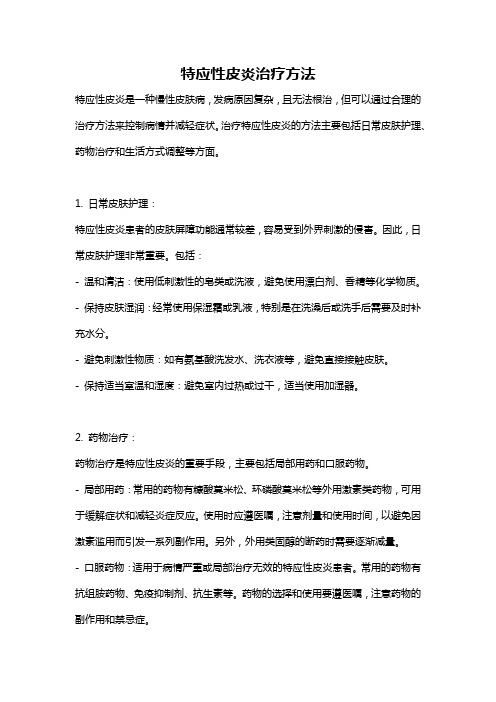
特应性皮炎治疗方法特应性皮炎是一种慢性皮肤病,发病原因复杂,且无法根治,但可以通过合理的治疗方法来控制病情并减轻症状。
治疗特应性皮炎的方法主要包括日常皮肤护理、药物治疗和生活方式调整等方面。
1. 日常皮肤护理:特应性皮炎患者的皮肤屏障功能通常较差,容易受到外界刺激的侵害。
因此,日常皮肤护理非常重要。
包括:- 温和清洁:使用低刺激性的皂类或洗液,避免使用漂白剂、香精等化学物质。
- 保持皮肤湿润:经常使用保湿霜或乳液,特别是在洗澡后或洗手后需要及时补充水分。
- 避免刺激性物质:如有氨基酸洗发水、洗衣液等,避免直接接触皮肤。
- 保持适当室温和湿度:避免室内过热或过干,适当使用加湿器。
2. 药物治疗:药物治疗是特应性皮炎的重要手段,主要包括局部用药和口服药物。
- 局部用药:常用的药物有糠酸莫米松、环磷酸莫米松等外用激素类药物,可用于缓解症状和减轻炎症反应。
使用时应遵医嘱,注意剂量和使用时间,以避免因激素滥用而引发一系列副作用。
另外,外用类固醇的断药时需要逐渐减量。
- 口服药物:适用于病情严重或局部治疗无效的特应性皮炎患者。
常用的药物有抗组胺药物、免疫抑制剂、抗生素等。
药物的选择和使用要遵医嘱,注意药物的副作用和禁忌症。
3. 生活方式调整:特应性皮炎的发病与遗传、环境、生活方式等因素有关,因此,合理的生活方式调整可以对病情有一定的改善作用。
包括:- 尽量避免过敏原:对于已经确定过敏原的患者,应避免接触或接触到最小限度。
常见过敏原包括尘螨、花粉、宠物毛发等。
- 注意饮食:避免食用对自身过敏的食物,如海鲜、花生、牛奶等。
补充充足的维生素和蛋白质,有助于提高皮肤免疫功能。
- 管理情绪:情绪波动和压力都可能诱发或加重特应性皮炎的症状,因此,患者需要学会积极应对压力,保持良好的心态。
- 锻炼和睡眠:适量的锻炼可以提高身体免疫功能,保持良好的睡眠也有助于病情的缓解。
总之,特应性皮炎是一种慢性皮肤病,治疗需要长期坚持,包括日常皮肤护理、药物治疗和生活方式调整等方面。
特应性皮炎的治疗与护理

专家谈病特应性皮炎又叫特应性湿疹,是皮肤科常见的一种慢性、复发性、炎症性皮肤病,往往伴有过敏性鼻炎、过敏性哮喘等过敏性疾病。
特应性皮炎不会传染,但具有遗传倾向,当直系亲属中有人患有特应性皮炎则患病的概率较高。
辨别是否患有特应性皮炎要抓住“剧烈瘙痒”、“干燥”和“湿疹样皮损”的特征。
瘙痒是特应性皮炎最常见的自觉症状,可因过冷、过热的刺激、出汗、情绪变化、毛织品的接触而激发,夜晚、入睡前还可出现阵发剧痒。
特应性皮炎根据年龄可分为三期,婴儿期(出生~2岁)皮损以面颊、额及头皮多见,根据皮损特征分为渗出型、干燥型和脂溢型;儿童期(2~12岁)根据皮损表现分为湿疹型(与成人慢性和亚急性湿疹相似)和痒疹型(全身散发痒性丘疹);青少年与成人期(12岁以上)多为局限性干燥损害、红斑或丘疹,苔藓样变,伴灰白鳞屑和色素沉着,主要发生于肘、腘窝、颈前及侧部。
外用糖皮质激素和钙调磷酸酶抑制剂是特应性皮炎的一线治疗。
许多患者拿到药物后不知道如何使用,对“指尖单位”感到疑惑。
指尖单位是用来衡量药物涂抹量的,即从标准包装软管(管径为5毫米)挤到成人从食指指尖到第一指间关节的长度的剂量,这么多药量的药膏可以涂抹成人(涂药人)两个手掌的面积。
如果特应性皮炎发作时有皮损红斑,灼热而无渗液,可以炉甘石洗剂外涂,每日3~4次。
如果出现局部糜烂、渗出的皮损,可以用中药溶液冷湿敷,每次10分钟,每日2次,湿敷间隔期外搽抗生素药膏抗感染,局部干裂紧绷感时可以涂芝麻油、食用橄榄油等润泽肌肤。
如果局部出现干燥、脱屑、肥厚苔藓样皮损,应用油剂、膏剂充分滋润,一旦干燥就涂抹,也可以使用含有中药的软膏。
在正规医院专科医生的指导下规范用药,副作用很少发生,不必过分担忧。
中医药治疗特应性皮炎是个不错的选择,内服可以调理脏腑气机,减少复发,湿敷、外涂控制局部症状,多管齐下快速控制病情还能减少激素等药物的使用。
寻求中医药治疗需要到正规医院,医生会根据病人的情况制定最适合的方案。
特应性皮炎的最佳治疗方法
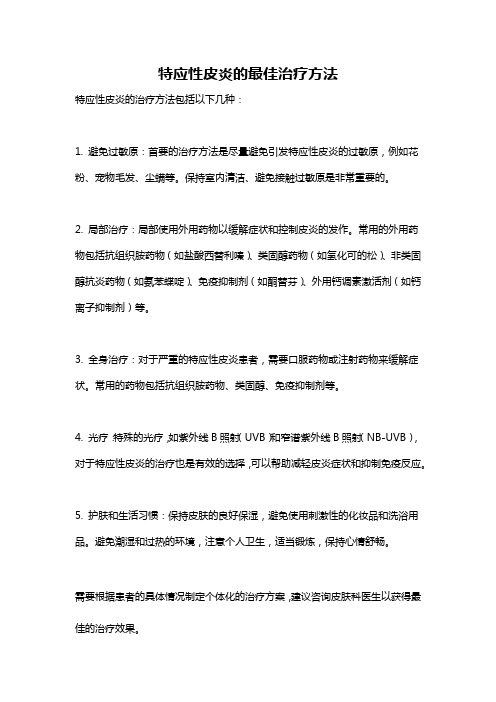
特应性皮炎的最佳治疗方法
特应性皮炎的治疗方法包括以下几种:
1. 避免过敏原:首要的治疗方法是尽量避免引发特应性皮炎的过敏原,例如花粉、宠物毛发、尘螨等。
保持室内清洁、避免接触过敏原是非常重要的。
2. 局部治疗:局部使用外用药物以缓解症状和控制皮炎的发作。
常用的外用药物包括抗组织胺药物(如盐酸西替利嗪)、类固醇药物(如氢化可的松)、非类固醇抗炎药物(如氨苯蝶啶)、免疫抑制剂(如酮替芬)、外用钙调素激活剂(如钙离子抑制剂)等。
3. 全身治疗:对于严重的特应性皮炎患者,需要口服药物或注射药物来缓解症状。
常用的药物包括抗组织胺药物、类固醇、免疫抑制剂等。
4. 光疗:特殊的光疗,如紫外线B照射(UVB)和窄谱紫外线B照射(NB-UVB),对于特应性皮炎的治疗也是有效的选择,可以帮助减轻皮炎症状和抑制免疫反应。
5. 护肤和生活习惯:保持皮肤的良好保湿,避免使用刺激性的化妆品和洗浴用品。
避免潮湿和过热的环境,注意个人卫生,适当锻炼,保持心情舒畅。
需要根据患者的具体情况制定个体化的治疗方案,建议咨询皮肤科医生以获得最佳的治疗效果。
特应性皮炎的治疗
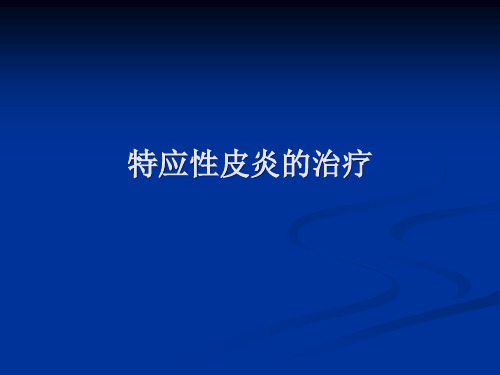
AD患者的皮肤皮脂腺数目减少,皮肤表面 的脂质物质含量降低,含水量减少,游离 脂肪酸的减少,改变了
局部治疗
1糖皮质激素 目前仍是治疗AD的一线药物。治 疗时应优先选用能够缓解症状的弱效激素,或者 使用强效激素迅速缓解症状,很快用弱效激素取 代
2 免疫调节剂 2.1 他克莫司 可推荐用于糖皮质激素类制剂疗 效不佳或者糖皮质激素不良反应明显的患者。 FDA推荐作为二线药物,用于其它治疗无效的患 者,短期间断使用,不宜用于2岁以下的婴幼儿
特应性皮炎的治疗
特应性皮炎是一种常见的慢性,复
发性,炎症性皮肤病,各年龄均可发病, 儿童最常见,其特点为皮肤干燥,瘙痒 剧烈,常有异位性家族史,发病机制尚 未完全明确,近年AD的发病率有明显 增高的趋势.
一般治疗
随着对皮肤的屏障功能和AD发病的相关性 认识的不断深入,恢复和保护皮肤的屏障 功能已经成为治疗AD的一个重要措施
局部治疗
匹美克莫司 1%匹美克莫司疗效不如1%他 克莫司,因其分子量较大,经皮吸收较他 克莫司及糖皮质激素药物少,因而安硫唑嘌呤 环孢素
系统用药
糖皮质激素 仅用于常规治疗无效以及严 重的AD患者,原则上禁用于儿童AD患者
抗组胺药物 应选用具有嗜睡作用的抗组 胺药物来治疗AD的瘙痒
系统用药
抗生素 AD患者的皮肤屏障功能被破坏, 角质层pH降低,易于继发金葡菌等微生物的 感染,金葡菌可通过释放超抗原,使AD复发或 加重,口服或外用抗生素防止或抑制继发感 染,对治疗AD有重要的临床意义
系统用药
但是抗生素治疗AD有以下不足: 在杀灭金葡菌的 同时,也会消灭皮肤表面的正常菌群,如表皮葡萄球 菌,削弱其对病原微生物的阻抑作用;还会使耐药致 病菌生长促使AD复发或加重;
特应性皮炎诊疗规范(2021年版)
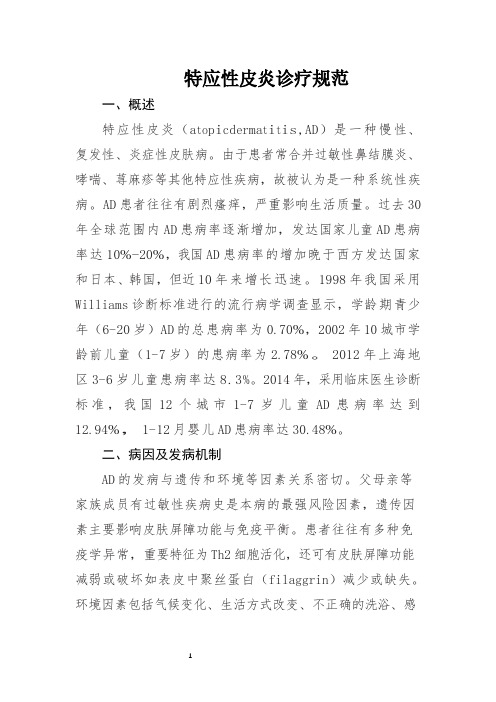
特应性皮炎诊疗规范一、概述特应性皮炎(a t o p i c d e r m a t i t is,A D)是一种慢性、复发性、炎症性皮肤病。
由于患者常合并过敏性鼻结膜炎、哮喘、荨麻疹等其他特应性疾病,故被认为是一种系统性疾病。
AD患者往往有剧烈瘙痒,严重影响生活质量。
过去30年全球范围内AD患病率逐渐增加,发达国家儿童A D患病率达10%-20%,我国AD患病率的增加晚于西方发达国家和日本、韩国,但近10年来增长迅速。
1998年我国采用Williams诊断标准进行的流行病学调查显示,学龄期青少年(6-20岁)A D的总患病率为0.70%,2002年10城市学龄前儿童(1-7岁)的患病率为2.78%。
2012年上海地区3-6岁儿童患病率达8.3%。
2014年,采用临床医生诊断标准,我国12个城市1-7岁儿童A D患病率达到12.94%,1-12月婴儿A D患病率达30.48%。
二、病因及发病机制AD的发病与遗传和环境等因素关系密切。
父母亲等家族成员有过敏性疾病史是本病的最强风险因素,遗传因素主要影响皮肤屏障功能与免疫平衡。
患者往往有多种免疫学异常,重要特征为Th2细胞活化,还可有皮肤屏障功能减弱或破坏如表皮中聚丝蛋白(filaggrin)减少或缺失。
环境因素包括气候变化、生活方式改变、不正确的洗浴、感染原和变应原刺激等。
现代生活方式(过于卫生、西式饮食等)及环境暴露(环境污染、被动吸烟等)等可能通过表观遗传修饰引起免疫系统与皮肤屏障异常,参与AD的发病。
此外,心理因素(如精神紧张、焦虑、抑郁等)也在AD的发病中发挥一定作用。
虽然AD的确切发病机制尚不清楚,但目前研究认为,免疫异常、皮肤屏障功能障碍、皮肤菌群紊乱等因素是本病发病的重要环节。
Th2型炎症是A D的基本特征,I L⁃4和I L⁃13是介导A D发病的重要细胞因子,主要由T h2细胞、嗜碱性粒细胞和2型固有淋巴样细胞(innatel y mphoidcells)等产生。
特应性皮炎的治疗方法有哪些
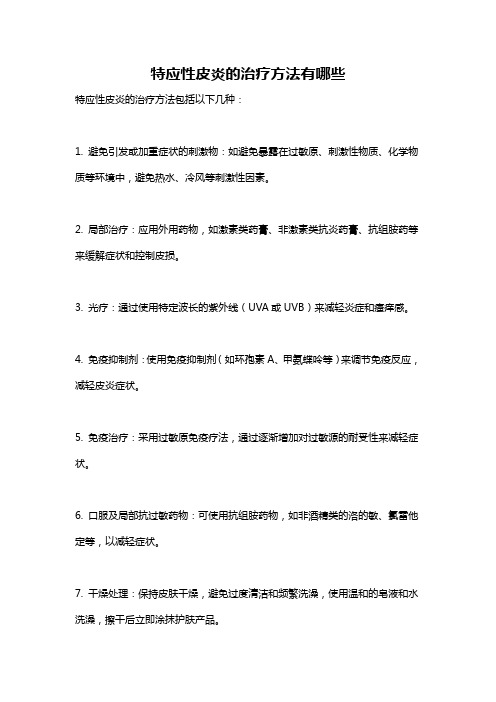
特应性皮炎的治疗方法有哪些
特应性皮炎的治疗方法包括以下几种:
1. 避免引发或加重症状的刺激物:如避免暴露在过敏原、刺激性物质、化学物质等环境中,避免热水、冷风等刺激性因素。
2. 局部治疗:应用外用药物,如激素类药膏、非激素类抗炎药膏、抗组胺药等来缓解症状和控制皮损。
3. 光疗:通过使用特定波长的紫外线(UVA或UVB)来减轻炎症和瘙痒感。
4. 免疫抑制剂:使用免疫抑制剂(如环孢素A、甲氨蝶呤等)来调节免疫反应,减轻皮炎症状。
5. 免疫治疗:采用过敏原免疫疗法,通过逐渐增加对过敏源的耐受性来减轻症状。
6. 口服及局部抗过敏药物:可使用抗组胺药物,如非酒精类的洛的敏、氯雷他定等,以减轻症状。
7. 干燥处理:保持皮肤干燥,避免过度清洁和频繁洗澡,使用温和的皂液和水洗澡,擦干后立即涂抹护肤产品。
需要根据个体情况制定针对性的治疗方案,建议在医生指导下进行治疗。
特应性皮炎的治疗指南

特应性皮炎的治疗指南特应性皮炎是一种常见的慢性皮肤病,以慢性反复发作为特征,常常伴有瘙痒和皮肤干燥。
该病的病因尚不明确,可能与遗传因素、免疫异常和环境因素等多种因素有关。
特应性皮炎的治疗目标是控制症状,减轻瘙痒和炎症,并预防复发。
以下是2024年特应性皮炎治疗指南的主要内容。
1.环境管理:避免暴露于刺激性物质,如尘螨、花粉、动物皮屑等。
保持室内空气湿润,避免干燥环境对皮肤的刺激。
2.皮肤保湿:使用保湿剂,如乳液、霜剂,多次涂抹,保持皮肤湿润,减轻瘙痒和干燥。
建议在洗澡后立即使用保湿剂,以锁住水分。
3.局部治疗:外用类固醇是特应性皮炎治疗的主要药物,能够迅速控制炎症和瘙痒,但长期使用有副作用。
应尽量选择短效和低浓度的外用类固醇,并遵循医生的用药指导。
局部非类固醇抗炎药物如钙调神经肽激动剂等也可选用。
4.全身治疗:对于严重和广泛的特应性皮炎,可以考虑口服抗组胺药物、免疫抑制剂或光疗。
其中,口服抗组胺药物可减轻瘙痒和控制过敏反应,但长期使用有副作用,应遵循医生指导。
免疫抑制剂如环孢素A和甲氧苄丙酮可用于严重病例,但需注意监测副作用。
光疗以UVB为主要治疗方式,能够减轻炎症和瘙痒,但需严格掌握剂量和曝光时间。
5.避免刺激性物质:特应性皮炎患者应避免接触刺激性物质和过敏原,如宠物毛发、化妆品、洗洁剂等。
同时,避免过度清洁皮肤,用温水洗澡,避免使用碱性洗剂。
6.控制感染:特应性皮炎易并发细菌和真菌感染,应避免抓破皮肤,保持皮肤清洁,如出现感染迹象,应及时就医治疗。
7.心理支持:特应性皮炎会给患者带来一定程度的心理负担,应给予患者充分的心理支持和教育,鼓励他们保持乐观积极的心态。
8.饮食调整:一些特应性皮炎患者对一些食物过敏,应及时发现并避免摄入。
此外,饮食宜清淡,少食辛辣刺激性食物,多食新鲜蔬菜水果。
9.加强护理:保持良好的个人卫生习惯,注意避免接触化学品和刺激物,穿棉质透气衣物,避免过度激活或受凉。
10.预防复发:特应性皮炎是一种反复发作的皮肤病,预防复发非常重要。
特应性皮炎的最佳治疗方法
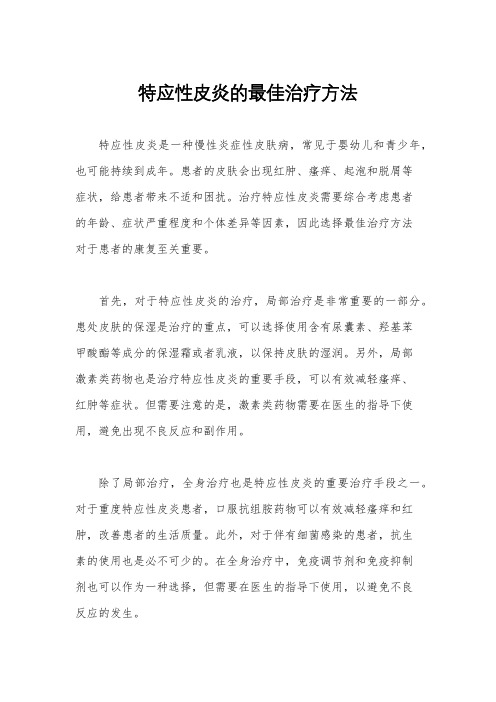
特应性皮炎的最佳治疗方法特应性皮炎是一种慢性炎症性皮肤病,常见于婴幼儿和青少年,也可能持续到成年。
患者的皮肤会出现红肿、瘙痒、起泡和脱屑等症状,给患者带来不适和困扰。
治疗特应性皮炎需要综合考虑患者的年龄、症状严重程度和个体差异等因素,因此选择最佳治疗方法对于患者的康复至关重要。
首先,对于特应性皮炎的治疗,局部治疗是非常重要的一部分。
患处皮肤的保湿是治疗的重点,可以选择使用含有尿囊素、羟基苯甲酸酯等成分的保湿霜或者乳液,以保持皮肤的湿润。
另外,局部激素类药物也是治疗特应性皮炎的重要手段,可以有效减轻瘙痒、红肿等症状。
但需要注意的是,激素类药物需要在医生的指导下使用,避免出现不良反应和副作用。
除了局部治疗,全身治疗也是特应性皮炎的重要治疗手段之一。
对于重度特应性皮炎患者,口服抗组胺药物可以有效减轻瘙痒和红肿,改善患者的生活质量。
此外,对于伴有细菌感染的患者,抗生素的使用也是必不可少的。
在全身治疗中,免疫调节剂和免疫抑制剂也可以作为一种选择,但需要在医生的指导下使用,以避免不良反应的发生。
除了药物治疗,特应性皮炎的患者还可以尝试光疗治疗。
光疗利用紫外线照射患处皮肤,可以减轻瘙痒、红肿和炎症,对于一些患者来说,光疗是一种有效的治疗方式。
但需要注意的是,光疗治疗需要在专业医生的指导下进行,以避免对皮肤造成伤害。
除了药物治疗和光疗,特应性皮炎的患者还需要注意日常护理和生活习惯的调整。
保持皮肤的清洁和干燥是非常重要的,避免接触过敏原和刺激性物质也是必不可少的。
另外,合理的饮食和作息也对特应性皮炎的治疗有着积极的影响,患者应该避免食用过敏原食物,保持良好的作息习惯。
总的来说,特应性皮炎的治疗需要综合考虑局部治疗、全身治疗、光疗和日常护理等方面。
患者在接受治疗的过程中,需要密切配合医生的指导,避免自行使用药物和治疗方法。
只有选择最佳的治疗方法,并且坚持治疗,患者才能够有效缓解症状,提高生活质量,达到康复的目的。
儿童和青少年特应性皮炎系统性治疗完整版
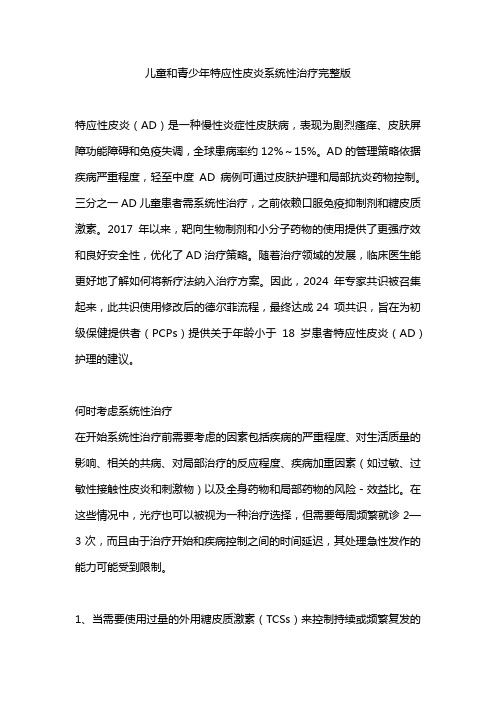
儿童和青少年特应性皮炎系统性治疗完整版特应性皮炎(AD)是一种慢性炎症性皮肤病,表现为剧烈瘙痒、皮肤屏障功能障碍和免疫失调,全球患病率约12%~15%。
AD的管理策略依据疾病严重程度,轻至中度AD病例可通过皮肤护理和局部抗炎药物控制。
三分之一AD儿童患者需系统性治疗,之前依赖口服免疫抑制剂和糖皮质激素。
2017年以来,靶向生物制剂和小分子药物的使用提供了更强疗效和良好安全性,优化了AD治疗策略。
随着治疗领域的发展,临床医生能更好地了解如何将新疗法纳入治疗方案。
因此,2024年专家共识被召集起来,此共识使用修改后的德尔菲流程,最终达成24 项共识,旨在为初级保健提供者(PCPs)提供关于年龄小于18 岁患者特应性皮炎(AD)护理的建议。
何时考虑系统性治疗在开始系统性治疗前需要考虑的因素包括疾病的严重程度、对生活质量的影响、相关的共病、对局部治疗的反应程度、疾病加重因素(如过敏、过敏性接触性皮炎和刺激物)以及全身药物和局部药物的风险-效益比。
在这些情况中,光疗也可以被视为一种治疗选择,但需要每周频繁就诊2—3次,而且由于治疗开始和疾病控制之间的时间延迟,其处理急性发作的能力可能受到限制。
1、当需要使用过量的外用糖皮质激素(TCSs)来控制持续或频繁复发的AD时,系统性治疗亦可作为考虑选项。
持续每天或频繁地使用高效TCS,或使用超过推荐量,都可能会导致不良反应,包括:皮肤变薄、色素沉着不足、皮纹形成和经皮吸收,并具有潜在的全身毒性。
因此,建议临床医生密切监测TCS的使用。
对于长期使用强效TCS但没有证据表明局部或全身副作用的儿童,目前尚不清楚如何定义“过度使用”。
在这些情况下,临床医生必须决定转向系统性治疗是否比继续使用当前的TCS应用方案更能为患者提供更大的利益和/或安全性。
2、在考虑启动非糖皮质激素系统性治疗时,应将糖皮质激素的总负荷纳入考量,这包括口服/全身、鼻内、吸入以及局部外用糖皮质激素(TCS)的使用。
